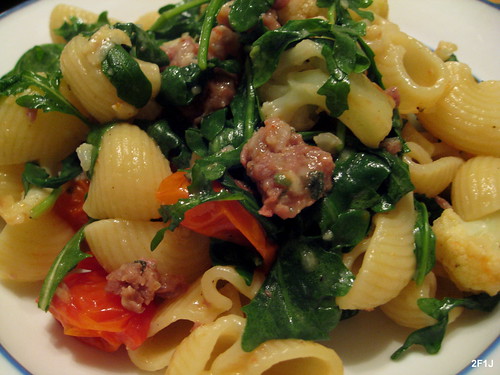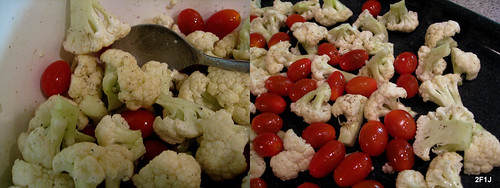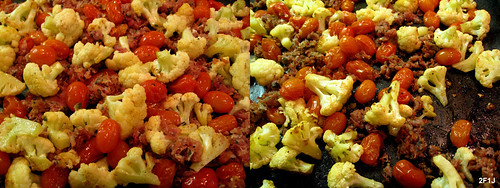Everybody knows that vegetables and fruits are good for you. They give us a wide range of important and valuable substances, like vitamins, carbohydrates, minerals, fiber and phytochemicals. From a young age one is always encouraged to eat your vegetables and Michael Pollan, who in recent years really helped to shape awareness in the US about the interplay of food, diet and environment, summed it up best with “Eat food, not too much, mostly plants”.
We eat out in restaurants quite frequently and even though we hardly have any limitations on what we eat and often prefer vegetable-focused dishes it still means that we eat quite a lot of meat at those dinners. As a consequence we tend to balance it by often cooking vegetarian dishes or dishes with hardly any meat at home. There are many vegetables which have a unique flavor and can stand at their own in a dish but on the other side there are also vegetables which have only a very subtle and easily missed own flavor, like cauliflower. Those vegetables could either be used in a dish with strong spices where they act more in the background or one could find a way to amplify the once subtle flavor of the vegetable so that it now can stand in the limelight. One way we often use to accomplish that is by roasting vegetables. The key for a successful roasting is the use of dry heat which is necessary to start the Maillard reaction. The Maillard reaction describes the reaction between a carbohydrate molecule and an amino acid. This reaction forms an unstable intermediate which after undergoing further changes produces myriads of diverse products. These products result in the browning and the characteristic flavor of roasted vegetables. The Maillard reaction can only start to occur at temperatures above 120 °C/250 °F which is above the boiling point of water and explains why boiled or steamed vegetables can’t produce this intense flavor. In addition, roasting also is responsible for the evaporation of water within the vegetables which will help to concentrate and again intensify the flavors. This dish of conchiglie with roasted cauliflower, arugula, and prosciutto is a nice example of the how roasting can accentuate the flavors of cauliflowers so that it has no problem to hold up against strong tasting ingredients as sage, arugula or prosciutto.
This seemingly simple pasta dish combines a surprising wide array of flavors. The roasting gave the cauliflower its characteristic “caramelized” yet slightly sweet flavor. Roasting grape tomatoes help to lower their acidity and boost their natural sweetness which worked in concert with the cauliflower. This sweetness is balanced by the peppery taste of arugula and the saltiness of the prosciutto. What really made this dish special was the inclusion of sage. Sage has a very unique and complex flavor profile combining hints of bitterness with savory and minty tones which can often dominate dishes and overshadow other ingredients. In this dish it is clearly discernible but at the same time supports the flavors of the other ingredients. A light red wine would accompany this dish perfectly.
Pulse sage and garlic in a food processor until minced. Add prosciutto and pulse until chopped. Preheat oven to 220 °C/425 °F.
Mix cauliflower, grape tomatoes, olive oil, ¾ tsp salt and ½ tsp pepper and spread vegetables in a single layer on baking sheet. Toast in the oven for 15 minutes stirring twice.
Add prosciutto-sage mixture to cauliflower and roast for 8 minutes.
Cook conchiglie until al dente. Reserve one cup of pasta-cooking water. Drain pasta and return to pot. Mix pasta with roasted vegetable mixture, arugula, cheese and some pasta water. Season with salt and pepper.
Recipe adapted from “Fine Cooking”
Serves 4
Medium-sized cauliflower, cored and cut into ¾-inch florets
500 g (1 pint) grape tomatoes
3 tbsp olive oil
9 large sage leaves
4 large garlic cloves, peeled
120 g (4 oz) prosciutto
150 g (5 oz) arugula
340 g (12 oz) dried conchiglie pasta
80 g (3 oz) Parmigiano-Reggiano, grated










5 comments:
This pasta dish is simple yet nutritious from the common super meaty kind of pasta out there. I guess it still tastes good with seasoned fish strips as alternative to ham.
I can't wait to try this when the veggies are in season. I will store this recipe away until then. Some interesting readin--thanks!
Tina - It would be an interesting idea to use fish instead of the proscuitto. Perhaps some stronger tasting ones like, smoked trout would work.
Eliotseats - You should try it. I guess that is one of the advantages living in Southern California that some veggies are always in season.
hello TF-OJ! what a terrific recipe! so many different flavors and textures. i will have to make this very soon. we are trying to cut down our meat consumption and eat more healthful meals. i enjoyed the scientific explanation as well! :)
CC - You should try it. It's always hard to cut out the meat in dishes but recently we are cooking more soups for dinner where you can do many flavorful things with out much (or any) meat.
Post a Comment